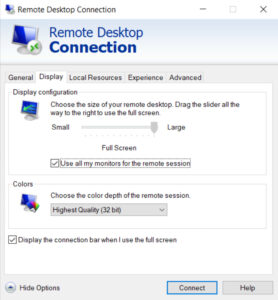May 20th, 2020
Self-isolation often means working from home—with a host of new challenges. To improve your productivity and make sure you keep boundaries between your professional and personal life, follow these tips:
1. Use a wired internet connection instead of WiFi WiFi is slower and more prone to interference from surrounding appliances and neighbors. If you can’t reach your router directly or dislike the idea of running a long ethernet cable to your computer, consider an adapter to extend a wired connection through an electrical outlet.
2. Use headsets during calls Headsets cut down on background noise—both for you and for others on the call. Wireless Bluetooth ones are convenient, but even the most basic headset can make a difference in improving call quality.
3. Split screens with Remote Desktop If you are used to multiple monitors in your work environment, you can replicate that option even at home when using Remote Desktop connections. Simply check “Use all my monitors for the remote session” under Display Options when you connect to Remote Desktop.
If you are used to multiple monitors in your work environment, you can replicate that option even at home when using Remote Desktop connections. Simply check “Use all my monitors for the remote session” under Display Options when you connect to Remote Desktop.
4. Use technology to communicate. A lot. Working from home means losing the ability to pop by somebody’s office for a question or having that quick chat around the coffee pot. To offset the loss of flexibility, you’ll need to make an extra effort to communicate more frequently, especially when coordinating schedules, availability, expectations and updates. Email and messaging are great tools, but they are often too easy to ignore or overlook. Phone calls and video chats—whether one-on-one or in work groups—also socialize your work environment. Only a small portion of communication is conveyed through the words we use. Tone of voice and body language are significant communication elements that are easily lost while remote working.
5. Stay connected with your coworkers WFH can engender loneliness, isolation, and feeling disconnected from colleagues. It lowers productivity and motivation and can become a drag on your mental health and awareness. Socialize with your teammates by checking in with them, asking about their weekends and simply carrying on conversations that were normally conducted during the workweek. Messaging apps such as Microsoft Teams and Slack are great tools for staying connected along with occasional videos chats to increase the feeling of connection.
Give yourself permission to stop your workday just like you did when you used to leave the office.
6. Develop your workspace Boundaries are needed to separate work life from personal life when working from home. You’ll need to establish a daily routine and schedule, communicate that schedule with coworkers and try to stick with it as much as possible. Plan activities for yourself before and after your workday to simulate the commute and create a separation between work and personal life. Go for a walk, listen to music, watch a tv show, or cook a meal—do whatever feels good to transition in and out of working. Make sure your workspace is physically comfortable and separate from your home space as much as possible. If you cannot devote a separate room as your office, try to work in a single place. At the end of the day turn off the computer to help you resist the urge to peek in at tasks. Give yourself permission to stop your workday just like you did when you used to leave the office.
Working at home creates a unique set of challenges that are different from your normal office. But when best practices are utilized, these challenges can be overcome. And don’t forget to be gentle and patient with yourself and your coworkers, even if your day gets crazy! After all, we are in this together.
Blog written by Ryan Byrd | Senior Data Analyst
